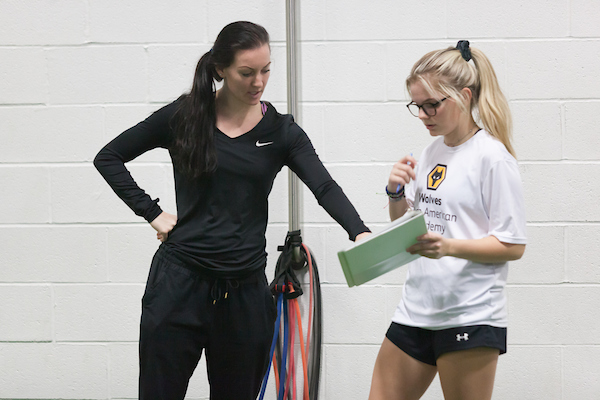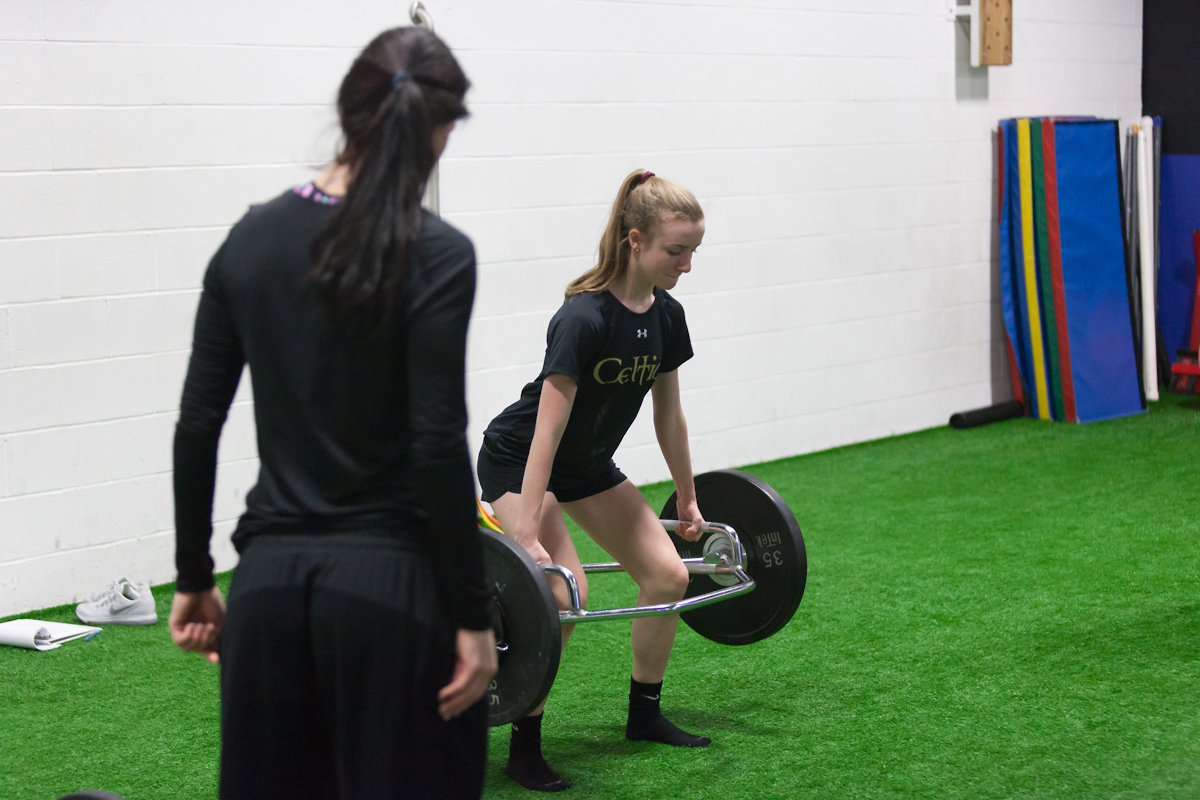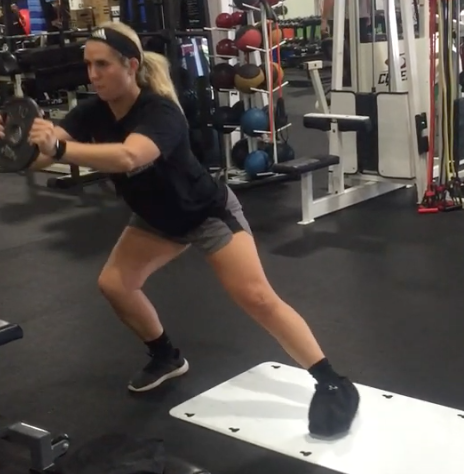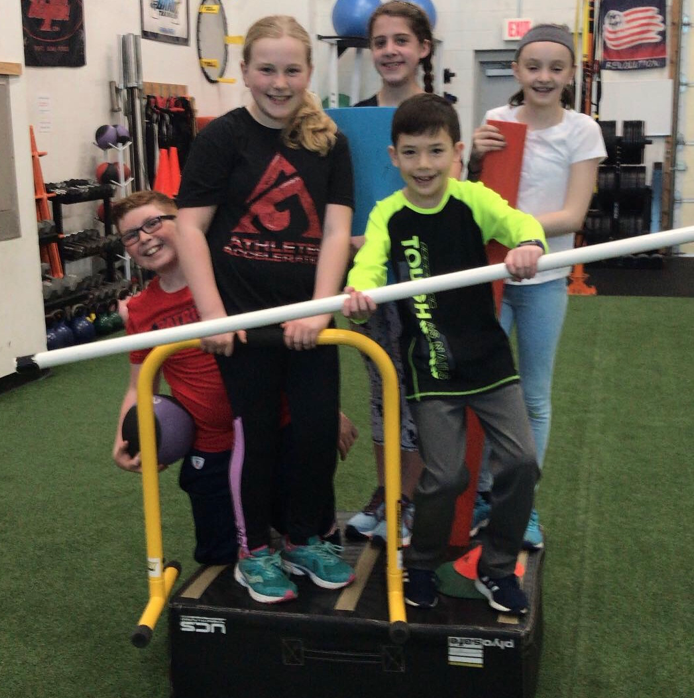
16 Aug Off-Season Speed, Conditioning and Strength Training For Soccer: Two Coaches Discuss What It Takes
Fun fact: no one knows what it takes to train in the off-season.
Okay, okay, before you get triggered, here I am explaining why in this two minute video:
You see? Off-season training is no joke. It’s long. It’s a grind. It’s a process.
As a coach, it warms my heart to wrap up this demanding time of year, and I couldn’t be more proud of my athletes for their effort this summer, but also, the other athletes who put in the work to build their athleticism. Not only did they become stronger, faster and more resilient, they learned how to enjoy the oscillating process of off-season – the highs, the lows, the challenges, the victories and feats of strength, the team building, the competition, the pushing past discomfort and so much more.
Truthfully, the ability to lean into this type of process and live it out to its fullest is when the magic happens.
Too, I can think of several analogies of amazing things that birth from an extended process:
1. Rome wasn’t built in a day.
2. A flower doesn’t bloom overnight.
3. A medium rare filet isn’t cooked in a split second.
4. A butterfly doesn’t burst out of its cocoon right away.
5. A Fitsoccerqueen doesn’t write her 567th article in year one.
Maybe you’re nodding your head in agreement.
Maybe you’re impressed I appreciate medium rare steak.
Maybe you’re floored this is my 567th article
Or maybe you’re annoyed and thinking, “gee, Erica, I’ve had it with you preaching the process!”
Well, too bad. I ain’t no wizard who taps her staff and gets people quick results.

I’m a coach who embodies a long-haul mindset.
And if you’ve followed this blog for a length of time, you know what I’m about:
My mission is to build youth athletes under a long-term development plan that takes months, if not years, of improving strength, power and speed.
Too, this plan must be safe, gradual, fun, and inspire them to love fitness for a lifetime. Rushing any of this is sure to leave a bitter, resentful taste in their mouths, or worse yet, cause an injury.
It’s sad. I wish more people fell in love with the process and took their time to water their athletic development like a flower in bloom.
But alas, it’s an interesting time to be a youth athlete. For one, kids are under pressure from parents, social media, friends, clubs, the DA and U-7 Combine Tryouts to perform and accomplish goals rapidly.
People are fixated on the end goal, the college commit post on Facebook, or the professional contract, they forget the rewarding steps it takes to get there. The necessary steps with the blood, sweat and tears.
Taking the conversation back to off-season training, most people don’t know what it takes to be in a high performance environment during the summer months.
Funny enough, before the madness begins, I say to my athletes, “get ready to go to Hell and back.”

And it’s true.
The level of commitment is immense, and the training is rigorous. Between my facility walls are only hard working athletes who understand physical development doesn’t come easy. They understand this place ain’t Candyland. Or Barbie’s World. Or The Shire. Or an ice cream parlor in Disneyworld.
It’s a construction site. It’s Mount Doom. It’s the Battle of Minas Tirith. It’s Survivor: The Amazon.
From the lung-burning conditioning drills, to the heavy strength loads, to the competitive speed and agility drills, to the long, ab ripping core circuits, to the butt firing hip circuits, and to the quantifiable load tracking, my kids know how much grit you need to get the most out of off-season.
Yes, we went boxing on Saturday mornings.
Yes, we don’t mess around.
In order for kids to truly become beasts in the off-season, they need to be training 2-4x a week consistently over 2-3 months under a periodized strength and conditioning plan.

If you’re the good-old-one-time-a-weeker, don’t blame your strength coach for your lack of progress, or your inability to fly down the wing at top speed.
Blame yourself for not prioritizing your athleticism. Just like your hygiene and brushing your teeth daily, your muscles need the same care.
Sure, one time a week isn’t enough, but even just one month of training a 2x a week isn’t enough.At most, you’ll get sore and learn how to lift.
Truthfully, I always find it funny when after just month one, kids exclaim, “I’m so sore!” due to the nature of the hypertrophy phase and delayed onset muscle soreness, when they have no clue that they’re just getting into the meat of the program.

There’s something to be said about that first month: the foundation is accomplished in that time. Then, the next month is when the true strength, speed and power development can happen.
So if you think just one month of training will prepare your child for the demands of the game, it doesn’t do much. I remember our first month ending, and my athletes were just getting the hang of the movements. To say it was a “teaching” month, is an understatement.
Rushing things never turns out well – in academics, skill acquisition, personal development, or physical fitness.
In fact, there are very few things in life that should be rushed: performing shock trauma in the ER, giving a choking victim the Heimlich, jumping in front of a bus to save a kid, putting out a fire before it burns your house, or running from a zombie.

That’s about it. Everything else? Take your freaking time.
So what should off-season look like for soccer players?
Let’s do this:
Month One: Adaptation Phase
Allow me to nerd out for a bit: this is my favorite phase because most youth soccer players do not have three practices a week and two games on the weekend.
*cue gates of heaven opening*
At this point, I’m amped up about not making kids too sore from a solid adaptation phase of high set and rep resistance training.
No games on the weekends calls for extra eccentric loading of the hamstrings (set range: 2-3, rep range 8-10, RPE: 6-7/10).
And more quadricep volume:
For the folks who fear knee injury, this adaptation phase off from games and to focus on high volume training is for you.
Nothing shouts ACL injury reduction more than truly being able to load the quads, glutes and hamstrings and hip muscles. Of course, soreness is inevitable, but with the nice time off from games (hopefully you aren’t making games and practices mandatory unless you have nationals), players are able to recover faster from gym sessions.
Month Two: Strength and Power, Agility, Conditioning
Without going into too much of a dissertation, here’s what you need to know about Month Two: we’re pulling some heavy weight at low reps (1-5) and getting explosive with power training to optimize fast twitch muscle fiber recruitment for improve speed, kicking, and accelerating.
For something like Box Jumps, it can take a while to truly improve. Motor learning in terms of the countermovement and then being able to stick the landing with confidence can take weeks, if not months.
For other power exercises like Medicine Ball Slams, kids need to continue to lift heavy so they can keep upping the ante on power production with balls higher than 16 pounds:
As far as the running piece, this is when kids get uncomfortable and are pushed to their limit. I’ll be honest: we didn’t do any long distance running in the facility or on the pitch all summer (Dave will touch on this in his portion more).
That said, my favorite conditioning drills are 300-yard shuttles, 5-10-5 shuttle runs working up to >90% of heart rate max/9-9.5 on RPE scale, or Figure 8 runs also working up to >90% of heart rate max. And the best part? These bouts don’t last longer than 60 seconds.
Sure, an under 6-minute mile is something I will laud, but I prefer kids do that on their own. The last thing I want to do as a strength coach is stand at a high school track with a stopwatch in-hand. Instead, I feel it’s my job to put them through conditioning drills that are 1) a higher intensity than the game and 2) applicable to the game with deceleration and change of direction in a controlled environment.
Do your work. Run with intensity. Then go home and drink a protein shake.
What about agility?
We did a lot of race and chase and competitive drills that brought out the best movement patterns in the kids.
Here is one fun game we did that didn’t need a ton of technical coaching. Still, it elicited nice shin angles, low center of mass, and high-speed competition:
And as far as speed training, we did resisted sprints with bands, sleds, and maximal speed bodyweight chase drills over a 40-yard distance, since players don’t get enough of it in small-sided games at practice:
Month Three: Strength, Sport Specific Conditioning, then De-Load
You see how lengthy and meticulous of a process this is? And that was just the first two months. This is why I tell leads who reach out to me in July that they’re already late to the party of off-season development.
And this is why I tell people who cram one-mile run tests in the week before tryouts, they’re morons.
And this is why I tell parents who want a high school prep camp package three days before tryouts, they need to find the nearest church and pray.
The final leg of off-season requires a major grind when it comes to strength training with bodyweight pull-ups:
Heavy single-leg strength at a 3-5 reps range:
And heavy bilateral strength in the 1-3 rep range with a nice 2-3 minute recovery of meandering around the facility:
And paused bench press variations, because, why not?
Please note: lifting heavier won’t make athletes sore if they are hanging out in an itty bitty rep range. Rather, it will make them resilient and confident.
Adding on to the heavy strength training, conditioning a few weeks out is at its peak and becoming more short, more intense and more sport specific.
Step into my arena, young ones, because we’re playing 1v1 Gladiator for 60 second bouts:
It’s brutal, to say the least.
Not only is this demanding physiologically, but mentally. There’s something grueling about competing against a friend for 60 seconds and trying to score more goals than them, while your lungs feel like they’re going to burst out of your skin.
The good news? They get a nice, long rest (2-3 minutes) before the next round. There have been days we have gone as many as 3 rounds. It’s enough, trust me. ;-O
I’d be remiss not to mention, a week before tryouts, we’re dialing down and my athletes are having fun. By this point, they’ve worked their tails off all summer to earn their de-load week, which encompasses no formal conditioning drills or tests, low rep strength movements that hit all muscle groups, and fun games that aren’t soccer:
Or we’re having a Farmer’s Carry Marathon to make us feel ripped and amazing going into tryouts (FYI: this was my boys’ idea, not mine):
Or, we’re having fun with grappling and wrestling games to get kids comfortable with contact:
Or, we’re out getting tacos:

Or, most of my kids are at the beach enjoying the last of summer vacation. I’m all for going on vacation a week before tryouts if you’ve busted your butt all off-season. Why the hell not?
With that said, I’m so freaking proud of all of the athletes who put in the work over the summer. It’s inspiring for us coaches and pumps us up knowing they’re healthy, resilient, and confident for in-season practices and games, and not scrambling with anxiety to be ready for pre-season.
I mean think about it, like critically think for a second: what are kids doing in their pre-seasons?
They’re being run into the ground, told by their coach to do 100 burpees for time, 100 squat jumps, and run a mile twice in less than 24 hours with a side of the Beep Test.
Yeah, don’t run kids hard the week before tryouts because you want them to go in fresh, relaxed and confident.
Alright, I’ll step off my podium and let soccer performance coach Dave Gleason from Athletes Acceleration South Shore step in to shed light on off-season training further.
My portion was just the warm-up.
So just like Khaleesi calling for her dragon for help to spit fire, take it away Dave.

At the start of my career if someone told me I would spend time defending the critical importance of off-season training, to say I would have been shocked would be an understatement.
A lot has changed since the mid-90’s I know…did I just date myself??
My hope is to allure you with some of the aspects of off-season training that in my opinion falls under the radar or even worse…is ignored. Shedding some light on this will give perspective that will encourage you to dig into your next off-season. If you’re a coach, I’m expectant of a shift in what your requirements are for your athletes.
The notion of pre-season can prove to be a difficult concept when the majority of athletes are seldomly void of in-season. If fact, it’s now at the point I’m often seeing club soccer running pre-season camps for the Fall. This is perplexing as the Fall club season for players in 8th grade, and younger, IS training and practice for the competitive Spring season.
Hmmmmm. So now we are having a pre-season for an extended pre-season?
That said, I don’t have a vocabulary that’s expansive enough to illustrate the importance of taking time off after the competitive season. For off-season training to create an injury resilient, strong, powerful and dangerously fast mega beast for the competitive season there must be an actual off-season!
…Oh and an off-season is not a measly 1 week of rest after winning a National Title, which extended the season by over a month, just to get back on the pitch with pre-season intensity the following Monday.
Yes this actually happens.
Why on earth would we subject younger, physically immature athletes to a higher volume demand than D1 college players?
It’s no wonder kids only feel up to training for 2 weeks before the season starts. They are beat down and tired especially if they are not in the gym on a consistent basis. This beat down and mentally and physically.
Consider this study published in March of 2019 looking at the ACL’s in more mature, Division 1 female soccer players at the University of Quinnipiac.
The gist of their findings…
The intense physical demand of a competitive soccer season in female collegiate athletes appears to cause an increase in volume of the ACL. The increase in volume of the ACL in this study may be related to the accumulation of microscopic tears over the course of the season which induce inflammation and edema of the ligament resulting in an increase in ligament volume.

You can read about it more here https://www.ncbi.nlm.nih.gov/pmc/articles/PMC6438997/ but in laymen’s terms this shows the stress an athlete’s body endures just over the course of one 2.5-3-month season.
But hey, what’s science have to with it? Like did we really need proof?
Do we really need more justification as to why young athletes need to prepare far ahead of time to play in the most competitive youth sports environment in history?
Listen, to no avail I’ve remarked in the past that sports performance has become the ‘weight loss’ of youth fitness.
Please indulge me while I explain.
The weight loss segment of the fitness industry is convoluted, confusing and in many ways dishonest to the general public. How many diets are there that don’t work, and are downright unhealthy? How many IG posts depict the quick and easy workout to get the body you’ve always wanted? Weight loss programs in every community all look the same to the general public and many times based off no factual science to produce long term results.
I think you get it.
The same is happening to the industry that Erica, myself and 100’s of dedicated professionals hold so close to our hearts.
Sports performance training is a science and an art. It’s nerdy and it’s human. It’s long term and it’s a ton of work. Off-season training is a critical component.
By extension, off-season training has too many paradigms associated with it that are incorrect and as mythical as a dragon.
- Off-season training is running long distance
- Off-season training is 2 weeks before tryouts/pre-season
- Off-season training is conditioning only
- Off-season training is lifting only
- Off-season training is easy
- Off-season training is a WOD
- Off-season training is a bootcamp
For the sake of my sanity and yours, I’ll stop there. Now rather than waste all of our time debunking this bullet point list…Let’s be more productive by digging into some super important aspects of proper off-season training.
Trusting the process
As Erica so perfectly laid out for us, the off-season has several distinct parts to it. The off-season is a process that cannot be rushed or abbreviated.

Just like in school, one aspect of the learning not only builds and prepares for the next step…the next phase will be far more successful for the athlete dependent on the successful completion of the previous phase.
Once more, cramming school work might get you an A short term but it will not help you move on to the next lesson…and eventually it WILL catch up to you when you realize you can no longer keep up in the class room.
Progress during the preseason is measured observed in a plethora of ways (in no particular order).
- Strength
- Power
- Explosiveness
- Speed
- Agility
- Mobility
- Flexibility
- Spatial Awareness
- Kinesthetic Awareness
- Mental Capacity/Decision Making
- Communication
- Emotional strength and Confidence
Every single one of these is a teachable skill.

That’s enough in itself but by no means a complete list. As you can clearly see there is inclusion to the no end in terms of what needs to be covered in an off-season program. Prioritizing factors such as these in effort to increase athletic ability on the field cannot include omitting a single one.
Leaving one out is like skipping algebra to get to chemistry.
It’s pretty clear that the over health and well-being and success of a young athlete is intricate, complex and comprehensive. Consistency over time for physical adaptation as well as mental toughness and self-confidence.
I must add, the MOST IMPORTANT aspect of any training program is to add to the individual athlete’s physical culture, love of movement and physical literacy as they move into young adulthood. Our society and their long term health depends on it.
Don’t’ expect long term results with short term programs. Our more successful Fall athletes started their off-season journey in May. Our most successful athletes train year-round with and off-season program dedicated to their needs.
Just because you did it as a kid doesn’t mean it’s the right thing to do.
I’d feel I failed you with this article if I didn’t mention this to you.
As a coach or parent that has the best intention of helping your athlete(s) reach their relative pinnacle of ability…make sure there is purpose behind what you are telling them to do well beyond it being something you did as a young athlete yourself.
If, by chance, there’s an activity that is part of their program that has you reflecting on your own glory days then good for you…you can share that commonality with them after the session is over if appropriate. However, it never starts there.
It’s not about you. It’s 100% about them, their goals and their individual needs.
The 2-mile enigma.
If you subscribe to the myth that long distance running is a great way to get in shape for a field sport like soccer be warned.
If you have failed to search for better measurables than a timed or untimed 2-mile run for tryouts it’s time to cover up like you’re in a 4-man wall on the top of the 18 with Cristiano Ronaldo in his superman pose behind the ball.
Let’s begin with the anxiety and stress imposed on young players due to the dreaded 2-mile test at tryouts. It’s completely unnecessary and usually yields a long-distance running routine with poor results. Far better use of their time to get focused, high intensity work on the ball on their own during that time.
Furthermore, if they don’t perform well on the 2-mile run they are down on themselves and going into the pre-season unconfident and with lowered expectations of themselves. Just what a coach wants, a bunch of less than confident slow runners for distance.
Which brings up my next point. Train long and slow. Be slow.
Working on SPEED (mechanics, acceleration posture, gait action, etc.) at a high enough intensity will yield players that can go longer and FASTER! Hello?
You are what you train to be. So, we train our athletes to be strong, fast champions. Run fast, walk, stop, turn and sprint, jog…sound familiar? That’s what happens on the field. A player NEVER covers 2 miles at a steady slow speed the entire time.
Yeah, yeah, I get it…traditional thinking is that it’s a good indicator of whose put in the work, or building an aerobic base with distance running is the place to start. The problem is both are false. Strength training and speed work is where to start. There are far better indicators of what players have come to tryouts prepared including the eye test.
First cuts are the easiest because in 10 minutes any coach can surmise great attitude and character as well as who can hang with the best with a great warm up routine and individual skill work on the ball at game speed.

Don’t want to throw more research at you God forbid it actually proves this so I’ll defer to friends like Julia Eyre for an unreal explanation of what Anaerobic Speed Reserve (ASR) is and why it’s important.
Of course, Mike Boyle has a tremendous amount of information of this subject as well all based-on research as well as decades training 1000’s of athletes. You can read one of his most famous articles on this here.
The clients that Erica and I worked on speed all summer crushed the 2-mile…most without doing one single training run even to get a benchmark because we knew what the result would be. Moreover, we were able to take the stress out of the long-distance running test and concentrate on helping them be their best.
Here’s the kicker. There’s a 50-70% injury rate for long distance running (depending on the research/literature you read). If I told you that a 4-4-2 formation will place half of your team on the bench with an injury would you discontinue it? You bet your center backs you would!
If your argument is team building. Think more. There are far better ways. That is all.
Relationships take time.

Developing a relationship with the strength coach is also paramount to the success of an athlete. The only skin we have in the game is that of helping our athletes be at their best. What gets us charged up is seeing our athletes pick up new skills and refine old ones as their pre-frontal cortex lights up like a Christmas Tree!
Witnessing our athletes transform into faster, stronger, more powerful and confident versions of themselves is what gets us out of bed every morning. Being part of that is something special and not taken lightly. We are on their team no matter how much success they have on the field.
Complete development is what a strength coach strives for. Thus, they have the cards stacked in their favor on and off the field. The more we get to know an athlete as a person beyond the pitch the more we can help. This takes time, patience and trust.
A young athlete will have different types of coaches throughout their athletic career. Some great, and yes, some not so great. EVERY coach will leave an indelible mark on the athletes they serve. A strength coach is in a unique position to leave a positive one beyond their comprehension.
For us, performance is not the goal…it’s the outcome.
It’s what happens when a true off-season is afforded to a young athlete so they can dedicate it to preparing for their future.
GET THE STRONG FEMALE ATHLETE BOOK, A SCIENCE-BASED APPROACH TO REDUCE INJURY, IMPROVE PERFORMANCE AND INCREASE CONFIDENCE IN FEMALE ATHLETES HERE

To get my speed, strength, agility and mindset book for youth athletes, GET TOTAL YOUTH SOCCER FITNESS ON SALE HERE.
ABOUT ERICA

Erica Mulholland is a former college 3x All-American soccer player and now Hall of Famer from Johns Hopkins University. She holds a Master of Science in Exercise Science and has been helping female athletes of all sports with speed, agility, strength, power, and conditioning for over 13 years. She has worked with soccer, lacrosse, track, volleyball, softball, and basketball girls, and has inspired her athletes to strength train not just for sport, but for life.
Her athletes have gone on to play college sports at University of North Carolina, University of Maryland, Pittsburgh, University of Southern California, University of Detroit, Mercy, Northwestern, Eastern Carolina University, Georgetown, West Point, University of South Florida, University of Charleston, MIT, Johns Hopkins, Carnegie Mellon, Rutgers, Towson University, and have gone on to play for professional various clubs in Europe.
Of course, she is proud of her athletes who made it to the college and pro levels, but she is most proud of her girls who stick with being strong and healthy for a lifetime. The training she does is about getting into good habits young, so girls can take these tools with them even after sports end.
Need more personalized help from Erica? BOOK A CONSULT HERE

Interested in Remote Training for Female Athletes? BOOK A CONSULT HERE
Get Erica’s first book THE STRONG FEMALE ATHLETE
Get Erica’s second book FEMALE ATHLETE HIGH PERFORMANCE

Check out her podcast: The Strong Female Athlete


Claudia Jones
Posted at 13:40h, 16 AprilThis is a great article, thanks!!
erica
Posted at 13:59h, 16 AprilGlad it helped, Claudia!